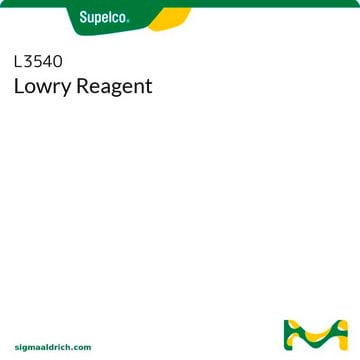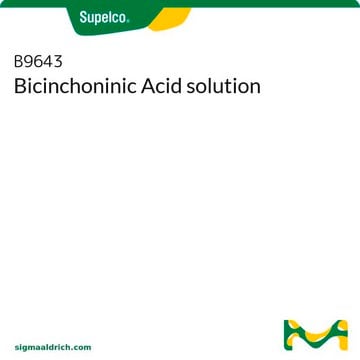B6916
Bradford Reagent
for 0.1-1.4 mg/ml protein
Synonym(s):
Coomassie dye binding protein assay, Coomassie dye binding protein assay, Protein dye reagent, Protein dye reagent
Sign Into View Organizational & Contract Pricing
All Photos(1)
About This Item
UNSPSC Code:
12161500
NACRES:
NA.32
Recommended Products
General description
Bradford assay is addition of coomassie brilliant blue G-250 to protein solution. The coomassie blue dye associates with basic and aromatic amino acids, thereby causing shift in absorbance during protein determination.
Application
Bradford Reagent has been used to determine total protein concentration.
Features and Benefits
- The reagent is ready to use. No mixing or dilution required.
- Color development is rapid. Only a five minute incubation and then the sample is read a 595 nm.
- Reducing sugars and reducing substances along with thiols do not interfere with this reagent.
- Reagent is suitable for micro (1-10 μg/ml) and standard (50-1400 μg/ml) assays.
- Can be used in microwell plate assays.
- Inexpensive assay.
Legal Information
Application
Product No.
Description
Pricing
also commonly purchased with this product
related product
Product No.
Description
Pricing
Signal Word
Warning
Hazard Statements
Precautionary Statements
Hazard Classifications
Eye Irrit. 2 - Met. Corr. 1 - Skin Irrit. 2 - STOT SE 2
Target Organs
Eyes,Central nervous system
Storage Class Code
8B - Non-combustible corrosive hazardous materials
WGK
WGK 1
Flash Point(F)
Not applicable
Flash Point(C)
Not applicable
Certificates of Analysis (COA)
Search for Certificates of Analysis (COA) by entering the products Lot/Batch Number. Lot and Batch Numbers can be found on a product’s label following the words ‘Lot’ or ‘Batch’.
Already Own This Product?
Find documentation for the products that you have recently purchased in the Document Library.
Customers Also Viewed
Influence of condensing equipment and temperature on exhaled breath condensate pH, total protein and leukotriene concentrations.
Czebe K et al.
Respiratory Medicine, 102, 720-720 (2008)
Caleigh Mandel-Brehm et al.
Neurology, 93(5), e433-e444 (2019-07-05)
To identify molecular correlates of primary angiitis of the CNS (PACNS) through proteomic analysis of CSF from a biopsy-proven patient cohort. Using mass spectrometry, we quantitatively compared the CSF proteome of patients with biopsy-proven PACNS (n = 8) to CSF
Proteomic response of the biological control fungus Trichoderma atroviride to growth on the cell walls of Rhizoctonia solani.
Grinyer J et al.
Current Genetics, 47, 381-381 (2005)
Rosenberg IM
Protein Analysis and Purification: Benchtop Techniques (2006)
Sin-Jin Li et al.
Clinical nutrition (Edinburgh, Scotland), 36(3), 760-767 (2016-06-28)
The cellular mechanisms of obesity-induced cardiomyopathy are multiple and not completely elucidated. The objective of this study was to differentiate two obesity-associated cardiomyopathy miniature pig models: one with the metabolic syndrome (MetS), and one with a metabolically healthy obesity (MHO).
Our team of scientists has experience in all areas of research including Life Science, Material Science, Chemical Synthesis, Chromatography, Analytical and many others.
Contact Technical Service












